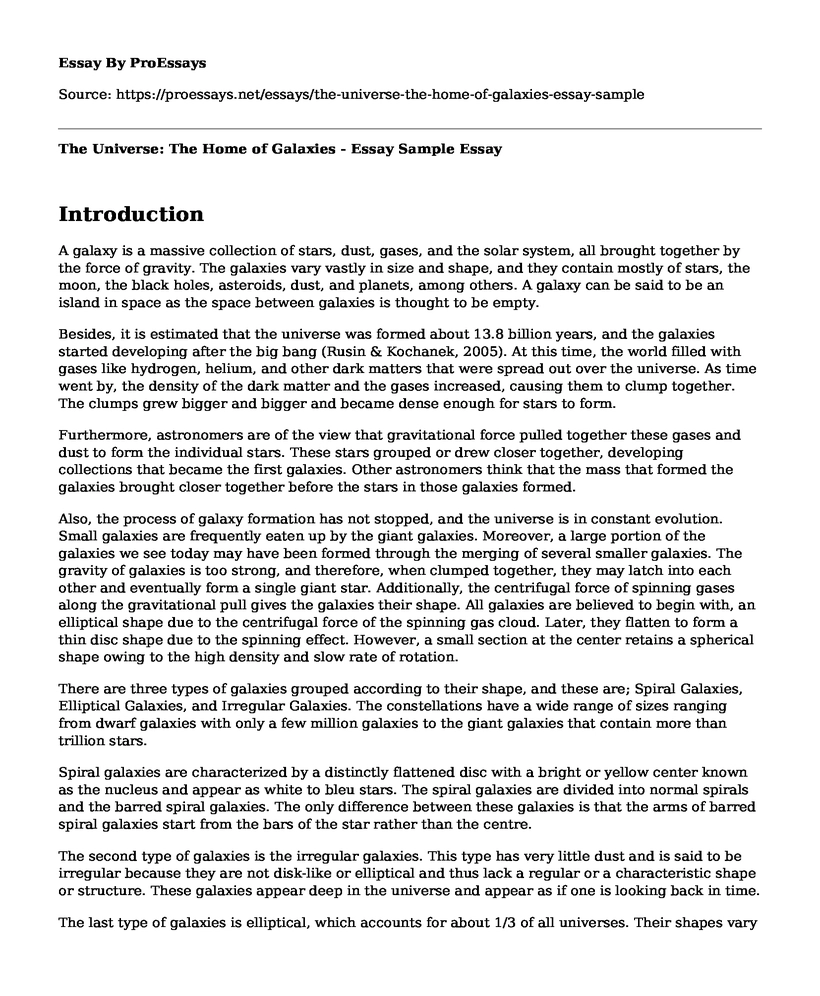Introduction
A galaxy is a massive collection of stars, dust, gases, and the solar system, all brought together by the force of gravity. The galaxies vary vastly in size and shape, and they contain mostly of stars, the moon, the black holes, asteroids, dust, and planets, among others. A galaxy can be said to be an island in space as the space between galaxies is thought to be empty.
Besides, it is estimated that the universe was formed about 13.8 billion years, and the galaxies started developing after the big bang (Rusin & Kochanek, 2005). At this time, the world filled with gases like hydrogen, helium, and other dark matters that were spread out over the universe. As time went by, the density of the dark matter and the gases increased, causing them to clump together. The clumps grew bigger and bigger and became dense enough for stars to form.
Furthermore, astronomers are of the view that gravitational force pulled together these gases and dust to form the individual stars. These stars grouped or drew closer together, developing collections that became the first galaxies. Other astronomers think that the mass that formed the galaxies brought closer together before the stars in those galaxies formed.
Also, the process of galaxy formation has not stopped, and the universe is in constant evolution. Small galaxies are frequently eaten up by the giant galaxies. Moreover, a large portion of the galaxies we see today may have been formed through the merging of several smaller galaxies. The gravity of galaxies is too strong, and therefore, when clumped together, they may latch into each other and eventually form a single giant star. Additionally, the centrifugal force of spinning gases along the gravitational pull gives the galaxies their shape. All galaxies are believed to begin with, an elliptical shape due to the centrifugal force of the spinning gas cloud. Later, they flatten to form a thin disc shape due to the spinning effect. However, a small section at the center retains a spherical shape owing to the high density and slow rate of rotation.
There are three types of galaxies grouped according to their shape, and these are; Spiral Galaxies, Elliptical Galaxies, and Irregular Galaxies. The constellations have a wide range of sizes ranging from dwarf galaxies with only a few million galaxies to the giant galaxies that contain more than trillion stars.
Spiral galaxies are characterized by a distinctly flattened disc with a bright or yellow center known as the nucleus and appear as white to bleu stars. The spiral galaxies are divided into normal spirals and the barred spiral galaxies. The only difference between these galaxies is that the arms of barred spiral galaxies start from the bars of the star rather than the centre.
The second type of galaxies is the irregular galaxies. This type has very little dust and is said to be irregular because they are not disk-like or elliptical and thus lack a regular or a characteristic shape or structure. These galaxies appear deep in the universe and appear as if one is looking back in time.
The last type of galaxies is elliptical, which accounts for about 1/3 of all universes. Their shapes vary from circular to ovoid and have little gas and dust and also compose of older stars and are no longer forming stars. Most are incredibly elongated and lack the bright nucleus at the center.
From the study of different galaxies, we learn that each universe has its collection of stars, planets, moon, black hole, comets, asteroids, dark matter, among other components. Our universe is part of the barred spiral galaxy called the Milky Way, and as the solar system, the galaxy is always in motion. Our galaxy is also very diverse and is extremely complex.
References
Rusin, D., & Kochanek, C. S. (2005). The evolution and structure of early-type field galaxies: A combined statistical analysis of gravitational lenses. The Astrophysical Journal, 623(2), 666.
Wang, J., Koribalski, B. S., Serra, P., van der Hulst, T., Roychowdhury, S., Kamphuis, P., & N. Chengalur, J. (2016). New lessons from the H I size-mass relation of galaxies. Monthly Notices of the Royal Astronomical Society, 460(2), 2143-2151.
Cite this page
The Universe: The Home of Galaxies - Essay Sample. (2023, Apr 08). Retrieved from https://proessays.net/essays/the-universe-the-home-of-galaxies-essay-sample
If you are the original author of this essay and no longer wish to have it published on the ProEssays website, please click below to request its removal:
- Some Questions on Physics
- Banning of Toxic Chemicals in Food by FDA Essay
- Research Paper on Examining the Reaction of Acid-Base
- Personal Statement: Georgetown MS in Mathematics and Statistics
- Essay Sample on History of Women in Mathematics
- Essay Example on Statistics: Math's Dominant Science for Data Analysis
- Essay Example on Calculating Drink Mix Mass for 0.24L Solution







